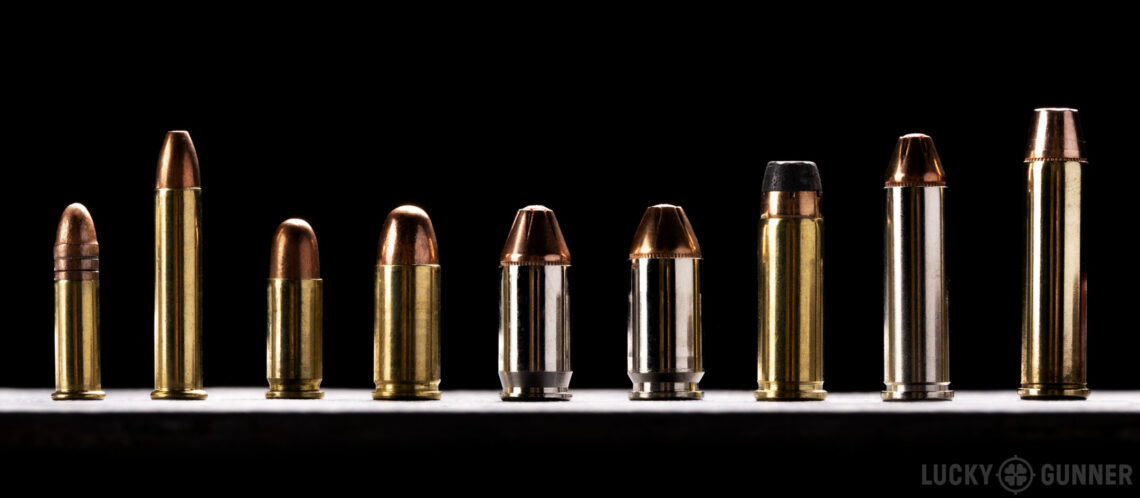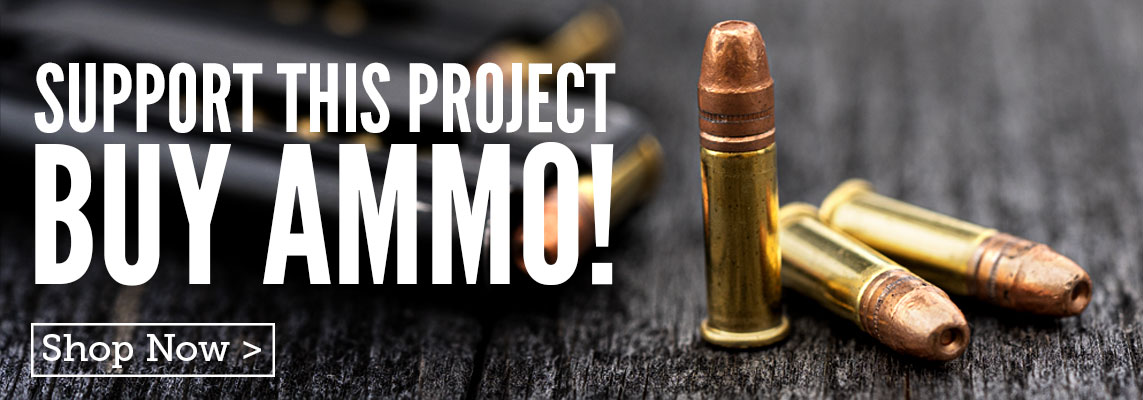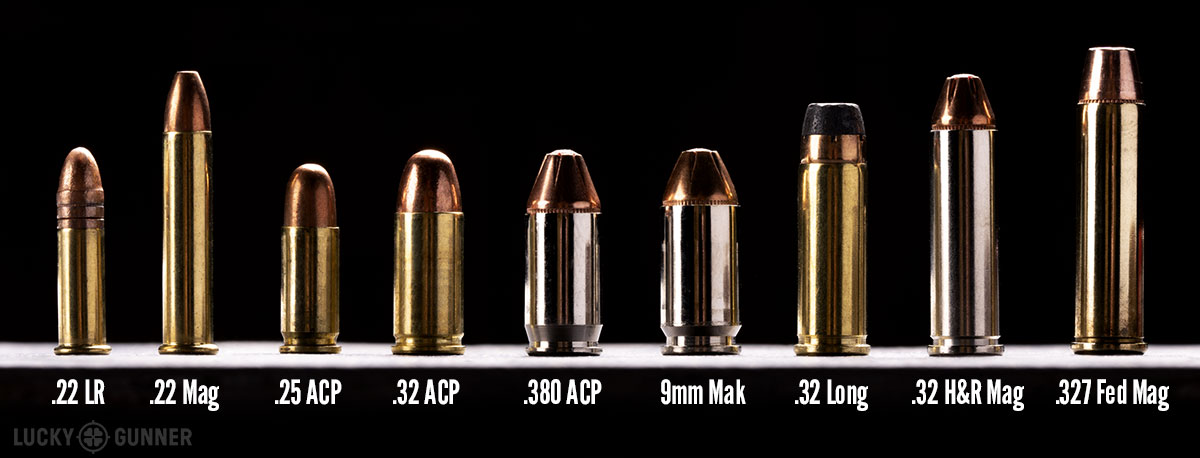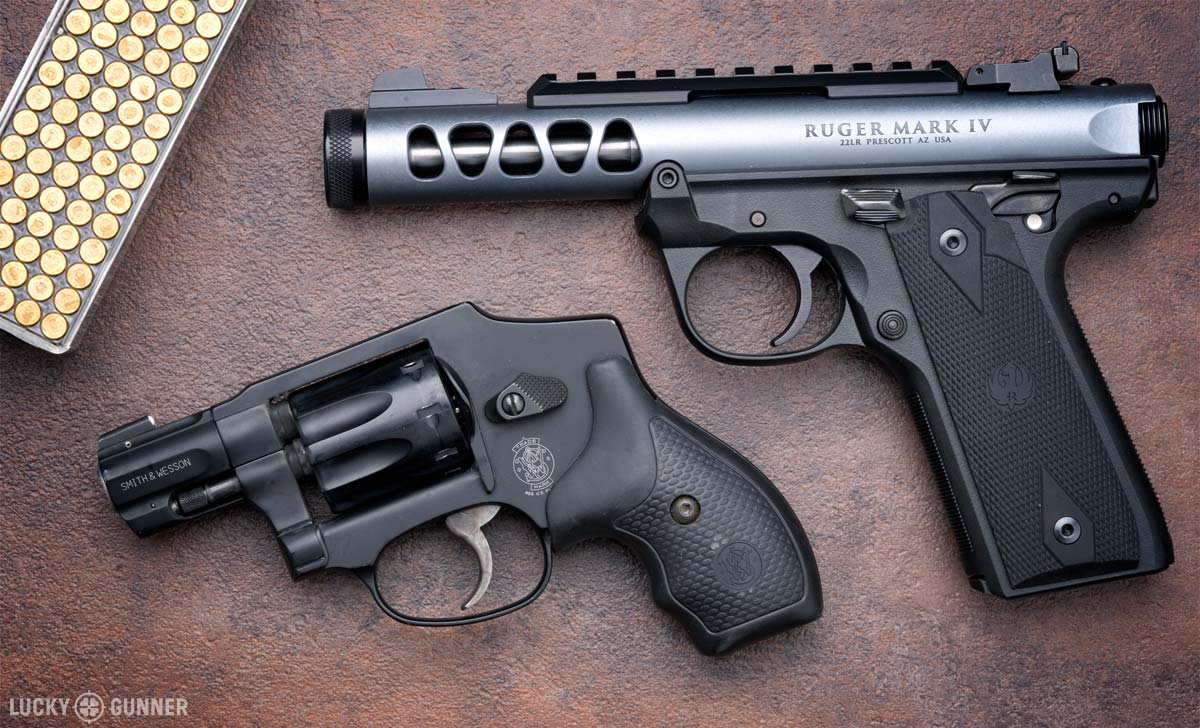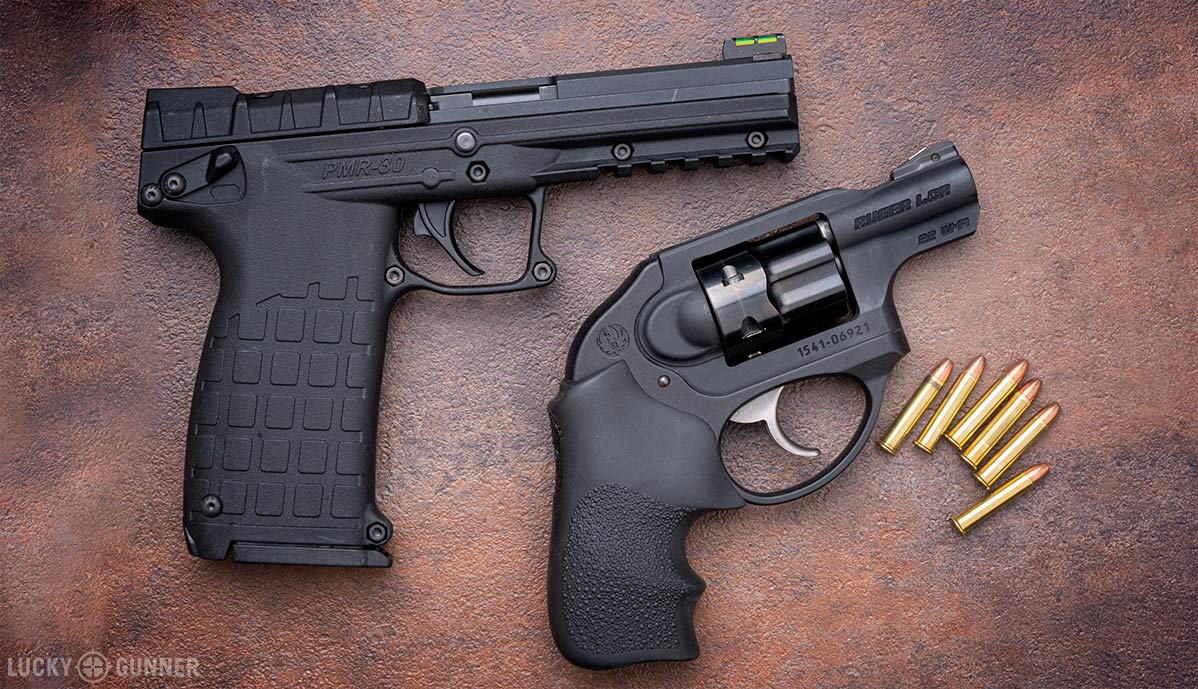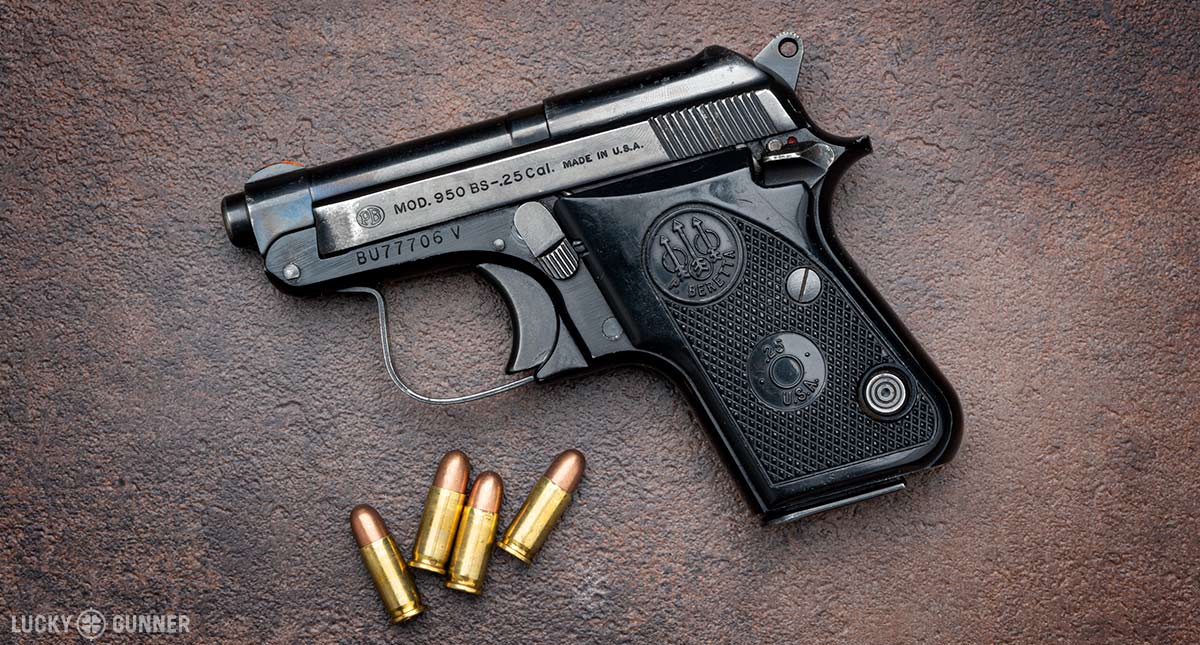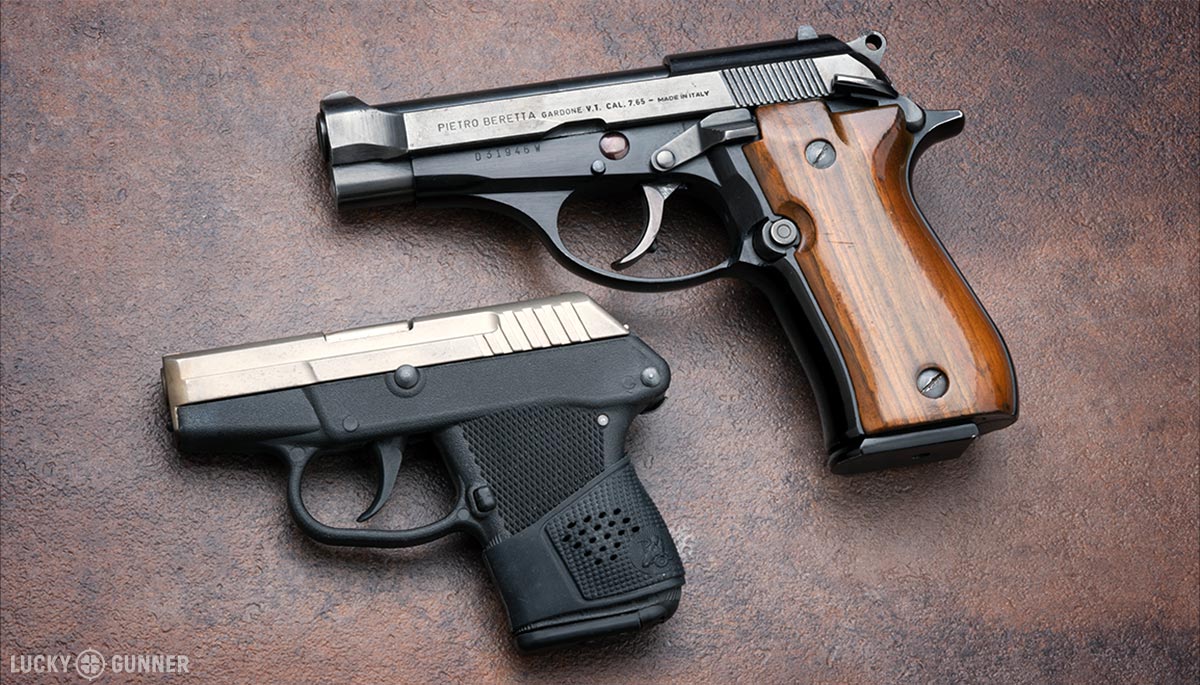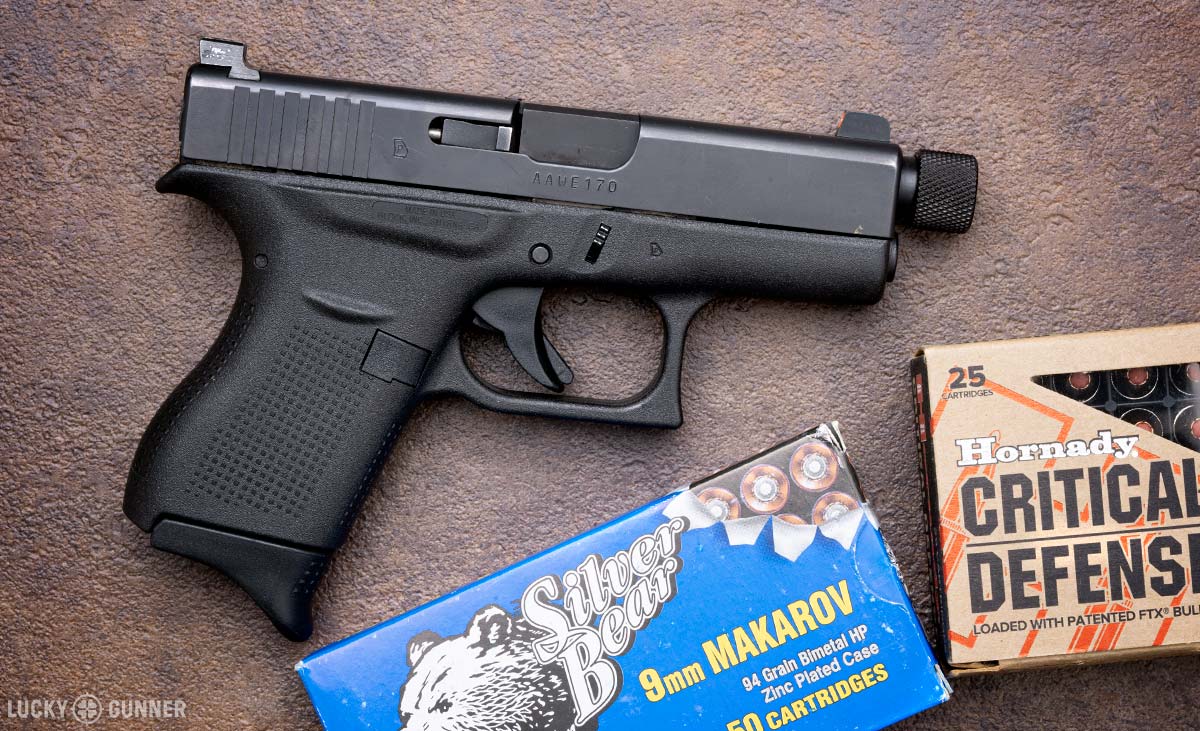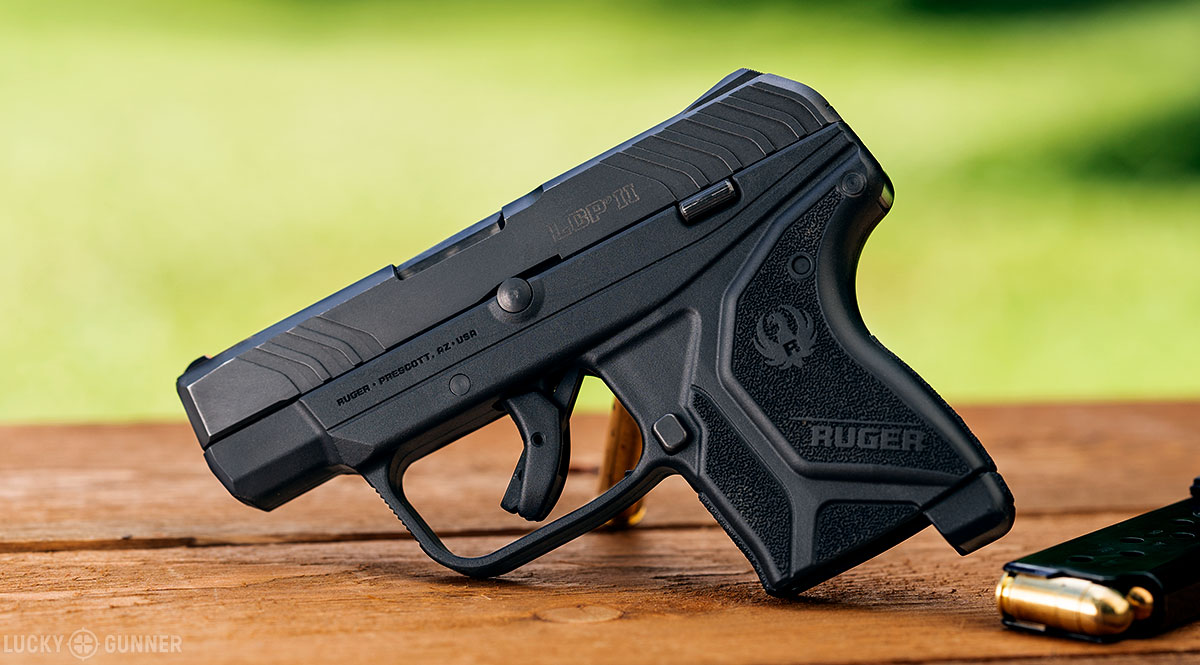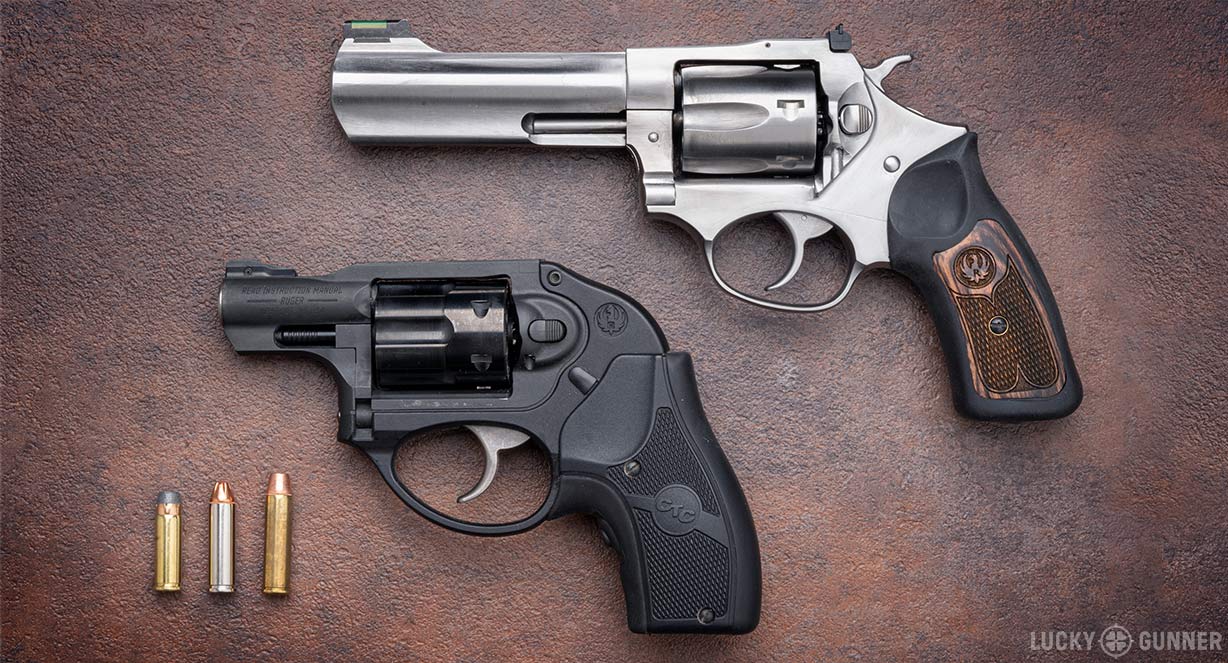Shortcuts
- .22 LR
- .22 Magnum
- .25 ACP
- .32 ACP
- 9mm Makarov
- .380 ACP
- .32 S&W Long
- .32 H&R Magnum
- .327 Federal Magnum
Project Overview
Since the very beginning of the series on pocket pistols that we started running on the Lounge (as well as YouTube) in late 2018, I have promising to add some of the smaller handgun calibers to our ballistic gelatin test project. Today, we are happy to finally be able to share the results from eight more calibers that we recently tested.
These new calibers fall into three categories below. For rimfire calibers, we tested .22 LR and .22 Magnum (aka .22 WMR).
The centerfire semi-auto cartridges were .25 ACP, .32 ACP, and 9mm Makarov. We could also have included .380 ACP in this category, but we already tested that caliber in our original batch of gel testing (and we’ve added a few newer .380 loads since that initial test).
Finally, we have the centerfire revolver calibers: .32 S&W Long, .32 H&R Magnum, and .327 Federal Magnum. Again, we could have included other calibers like .38 Special and .357 Magnum, but we’ve tested those previously.
Test Procedure (The Short Version)
For this batch of testing, we followed the same basic protocol we’ve used in all of our tests (outlined in painstaking detail back in our first gel test article). The short version is that we fired five rounds of each load into blocks of Clear Ballistics synthetic gelatin from a distance of 10 feet. A four-layer heavy clothing barrier was placed in front of the gel for each test. For most of these calibers, we used two test guns with different barrel lengths: one pocket pistol or snub nose revolver and one mid-size or compact test gun.
After each test, we measured the penetration depth of every bullet, then extracted the bullets from the gel to measure their weight and expanded width. We also took velocity readings of each load with a chronograph. All this information appears in the data charts below. If you click on the penetration section of the chart, you can see photographs of the actual bullets in the gelatin. Clicking on the thumbnails of the expanded bullets will give you a magnified view. And if you still want more info, you can click on the name of the load to go to its product page where we’ve published a detailed breakdown of the data and a high speed video of that load as it impacts the gel block.
Rimfire Pocket Pistol Calibers
.22 LR (.22 Long Rifle)
The two test guns we used for .22 LR were a Smith & Wesson 43C snub nose revolver with a 1.9-inch barrel and a Ruger Mark IV with a 4.4-inch barrel (rounded to 2″ and 4″ respectively on the chart below). We suspect the inclusion of a rifle-length barrel would also have yielded some interesting results. That’s something we would like to test in the future, but we decided to stick with handgun barrels for this batch of testing.
Using a .22 LR handgun for self-defense purposes is a controversial subject, and not one we’re going to cover here (check out this installment of the Pocket Pistol Series for more on that debate). Regardless of whether it’s a good idea, if one were to go this route, ammo selection should be based on achieving as much penetration as possible. Bullet expansion is unlikely and if it does occur, penetration will almost certainly suffer.
The size of the pistol also plays an important role. In our tests, even with the small jump in barrel length between the S&W snubby and the Ruger Mark IV, there was significant improvement in bullet performance in the gel. On average, the 4.4-inch barrel yielded a velocity increase of 126 fps over the 1.9-inch snubby barrel. It’s worth noting, however, that the loads with the highest velocity did not necessarily result in the best penetration.
.22 Long Rifle (LR) Ballistic Test Results
- Medium: Clear Ballistics Synthetic Gel
- Barrier: Four Layer Fabric
- Test gun: S&W 43C Ruger MKIV
| Ammo | Penetration depth | Expansion | Muzzle velocity | ||
|---|---|---|---|---|---|
| CCI 32 gr Stinger CPHP | 10.72 | 0.22 | 970.4 | ||
| Remington 36 gr Viper TC | 9.6 | 0.22 | 937.4 | ||
| Winchester 37 gr Varmint HE | 12.72 | 0.246 | 1002.8 | ||
| CCI 40 gr Velocitor CPHP | 13.06 | 0.22 | 887.8 | ||
| CCI 40 gr Mini Mag CPRN | 10.84 | 0.22 | 920.2 | ||
| CCI 40 gr Standard Velocity LRN | 9.98 | 0.22 | 812.2 | ||
| Aguila 40 gr Interceptor CPSP | 11.84 | 0.22 | 965.4 | ||
| Federal 40 gr Champion LRN | 11.56 | 0.22 | 952.4 | ||
| CCI 32 gr Stinger CPHP | 9.62 | 0.322 | 1160 | ||
| Remington 36 gr Viper TC | 11.62 | 0.22 | 1039.4 | ||
| Winchester 37 gr Varmint HE | 14.94 | 0.242 | 1109 | ||
| CCI 40 gr Velocitor CPHP | 15.58 | 0.22 | 1050.2 | ||
| CCI 40 gr Mini Mag CPRN | 12.4 | 0.22 | 1017.4 | ||
| CCI 40 gr Standard Velocity LRN | 12.32 | 0.22 | 913.4 | ||
| Aguila 40 gr Interceptor CPSP | 13.02 | 0.22 | 1113.8 | ||
| Federal 40 gr Champion LRN | 13.98 | 0.22 | 1055.6 |
* - indicates bullets that failed to retain an average of at least 85% of their initial weight
.22 Magnum (.22 WMR)
A common belief about .22 Magnum is that when fired from a short barrel, it does not achieve enough velocity to perform noticeably better than .22 LR. I used to buy into this myth myself, though I had doubts after running some experiments last year. It’s true that .22 Magnum does lose quite a bit of velocity in a short barrel compared to what it’s capable of in a rifle. However, our velocity measurements alone suggest that the conventional wisdom is questionable.
The average velocity of the five .22 Mag loads we clocked with our 1.9-inch Ruger LCR is 255 fps greater than the average of all the .22 LR velocities we measured with the S&W 43C. With the 4.3-inch barrel of the KelTec PMR30, the .22 Magnum loads gained an additional 135 fps on average. This increased velocity translated into better performance in gelatin as well. On the chart below, the barrel lengths have been rounded to 2″ and 4″.
The CCI, Fiocchi, and Winchester loads we tested are all conventional .22 Magnum loads designed primarily to be used for small game hunting with rifle-length barrels. Because of the velocity decrease from the pistols, none of these three rounds expanded in any of our tests. Penetration, however, was more than adequate with both test guns.
The Speer and Hornady ammo are specifically designed for self-defense use with short barrels. Both loads exhibited decent expansion with both test guns, but penetration suffered. Purpose-made self-defense expanding JHP ammo for .22 Magnum is a new phenomenon, but it doesn’t seem that the ammo makers have achieved ideal performance yet. As of now, .22 Magnum is still like most other pocket calibers: one must choose between good penetration with no expansion or mediocre penetration with good expansion.
.22 Magnum (WMR) Ballistic Test Results
- Medium: Clear Ballistics Synthetic Gel
- Barrier: Four Layer Fabric
- Test gun: Ruger LCR KelTec PMR30
| Ammo | Penetration depth | Expansion | Muzzle velocity | ||
|---|---|---|---|---|---|
| CCI 40 gr Maxi-Mag JHP | 15.8 | 0.22 | 1182.4 | ||
| Fiocchi 40 gr Performance JSP | 15.12 | 0.22 | 1170.6 | ||
| Hornady 45 gr Critical Defense FTX | 11.96 | 0.37 | 1107.2 | ||
| Speer 40 gr Gold Dot | 12.86 | 0.334 | 1140.6 | ||
| Winchester 30 gr Varmint HV V-Max | 14.2 | 0.22 | 1331.2 | ||
| CCI 40 gr Maxi-Mag JHP | 16.54 | 0.22 | 1313.4 | ||
| Fiocchi 40 gr Performance JSP | 16.16 | 0.22 | 1322.8 | ||
| Hornady 45 gr Critical Defense FTX | 13.62 | 0.402 | 1230.8 | ||
| Speer 40 gr Gold Dot | 14.72 | 0.418 | 1312.4 | ||
| Winchester 30 gr Varmint HV V-Max | 14.86 | 0.22 | 1429 |
* - indicates bullets that failed to retain an average of at least 85% of their initial weight
Semi-Auto Pocket Pistol Calibers
.25 ACP
Our test gun for .25 ACP was a Beretta 950 BS Jetfire with a 2.4-inch barrel. We only used one test gun for this caliber because .25 ACP pistols with longer barrels are extremely uncommon, especially today.
.25 ACP ammunition is known for its modest penetrating capability and our tests seemed to confirm that. We would have expected the FMJ load in this caliber to have the best potential for decent penetration, but it was still unimpressive overall, even compared to the JHP loads. Only one load managed to land all five bullets past the 11-inch mark and that was the Hornady FTX Critical Defense. An FMJ load with higher velocity might have yielded better results, as was the case in the informal gel test we performed with American Eagle FMJ last year. However, even that test showed inconsistent penetration from shot to shot. I typically do not offer concrete recommendations in these tests, but I would be very reluctant to rely on .25 ACP unless I had no other option.
.25 Auto (ACP) Ballistic Test Results
- Medium: Clear Ballistics Synthetic Gel
- Barrier: Four Layer Fabric
- Test gun: Beretta 950 Jetfire
| Ammo | Penetration depth | Expansion | Muzzle velocity | ||
|---|---|---|---|---|---|
| Fiocchi 35 gr XTP | 11.34 | 0.282 | 946.4 | ||
| Fiocchi 50 gr FMJ | 12.68 | 0.25 | 712.2 | ||
| Hornady 35 gr XTP | 11.82 | 0.25 | 870.4 | ||
| Speer 35 gr Gold Dot | 10.18 | 0.254 | 900.4 | ||
| Hornady 35 gr FTX Critical Defense | 11.82 | 0.25 | 839.6 |
* - indicates bullets that failed to retain an average of at least 85% of their initial weight
.32 ACP
For .32 ACP, our two test guns were a KelTec P32 with a 2.7-inch barrel and a Beretta Model 81 Cheetah with a 3.8-inch barrel (rounded to 3″ and 4″ in the chart below). The difference in barrel length between these two guns is only about half the difference between the barrels used for the other calibers with multiple test guns. After some velocity pre-testing, we decided to use these guns anyway because we were seeing a velocity increase of at least 100 fps with the Cheetah (with our gel test loads, the average increase ended up being 129 fps). Since .32 ACP pistols with barrels longer than the Cheetah’s are very uncommon, and the P32 has one of the shortest barrels on the market, we thought it made sense to stick with these two for our test guns.
Our testing of this caliber really demonstrates the potential superiority of FMJ loads in small handguns. All of the JHP loads tested had trouble penetrating at least some of the time. This was even true for those that failed to expand. The Fiocchi FMJ, on the other hand, demonstrated ideal penetration with the KelTec and even greater penetration with the Beretta (which may or may not be considered over penetration depending on who you ask).
.32 Auto (ACP) Ballistic Test Results
- Medium: Clear Ballistics Synthetic Gel
- Barrier: Four Layer Fabric
- Test gun: KelTec P32 Beretta 81 Cheetah
| Ammo | Penetration depth | Expansion | Muzzle velocity | ||
|---|---|---|---|---|---|
| Hornady 60 gr FTX Critical Defense | 11.78 | 0.338 | 864.8 | ||
| CorBon 60 gr JHP | 13.68 | 0.386 | 1098.6 | ||
| Fiocchi 60 gr XTP | 12.28 | 0.332 | 929 | ||
| Buffalo Bore 60 gr Tac-XP +P | 9.4 | 0.458 | 982 | ||
| Speer 60 gr Gold Dot | 10.1 | 0.31 | 858.2 | ||
| Hornady 60 gr XTP | 12.64 | 0.31 | 755 | ||
| Federal 65 gr Hydra Shok | 9.92 | 0.432 | 873.8 | ||
| Fiocchi 73 gr FMJ | 16.8 | 0.31 | 839 | ||
| Hornady 60 gr FTX Critical Defense | 10.9 | 0.398 | 980.4 | ||
| CorBon 60 gr JHP | 8.5 | 0.512 | 1183.4 | ||
| Fiocchi 60 gr XTP | 13.48 | 0.39 | 1095.6 | ||
| Buffalo Bore 60 gr Tac-XP +P | 9.14 | 0.588 | 1091.8 | ||
| Speer 60 gr Gold Dot | 9.8 | 0.438 | 983.2 | ||
| Hornady 60 gr XTP | 17.22 | 0.31 | 923.2 | ||
| Federal 65 gr Hydra Shok | 9.18 | 0.458 | 992.4 | ||
| Fiocchi 73 gr FMJ | 21.34 | 0.31 | 983.6 |
* - indicates bullets that failed to retain an average of at least 85% of their initial weight
9x18mm Makarov
We were on the fence about including this load in our testing. But when I mentioned the possibility in a video last year, enough fans of the 9×18 Makarov came out of the woodwork to convince us. There aren’t many loads available for this caliber. Rather than purchase an entire pistol just for testing three loads, we ordered a Lone Wolf 9×18 conversion barrel for our Glock 42 (originally chambered for .380 ACP). We went with the 3.76-inch extended threaded barrel because it’s closer to the 3.68-inch barrel of the original Makarov pistol (which remains the most common gun chambered for this caliber).
The S&B FMJ load penetrated almost to the end of the second block of gel. The Silver Bear JHP essentially did the same thing. There are a few other basic JHP loads out there for this caliber that are similar to the Silver Bear load, and I would expect them to have the same kind of performance.
If you’re looking for a JHP 9×18 Mak load that actually has any serious chance of expanding and penetrating, the only real contender on the market right now is Hornady Critical Defense. In our tests, this load exhibited decent performance, but was not an improvement over the .380 ACP version. Our test of the .380 ACP Hornady Critical Defense resulted in a an average penetration depth of 13.2 inches and average expansion of .52 inches. The bullet is slightly lighter (90 gr versus 95 gr for the 9×18) with slightly less velocity (910 fps versus 953 fps). Even so, the performance in gelatin between the two loads was comparable.
9mm Makarov (9x18mm) Ballistic Test Results
- Medium: Clear Ballistics Synthetic Gel
- Barrier: Four Layer Fabric
- Test gun: Glock 42 w/ Conversion bbl
| Ammo | Penetration depth | Expansion | Muzzle velocity | ||
|---|---|---|---|---|---|
| Hornady 95 gr FTX | 13.54 | 0.456 | 953.4 | ||
| Silver Bear 94 gr JHP | 26.38 | 0.35 | 1016.2 | ||
| Sellier & Bellot 95 gr FMJ | 28.5 | 0.35 | 963.8 |
* - indicates bullets that failed to retain an average of at least 85% of their initial weight
.380 ACP
Like we mentioned back in the introduction, we did not include .380 ACP in this batch of testing because we’ve actually already tested it. You can find the results from 20 different .380 ACP ammunition back in our very first gel testing article.
If you’re looking for more .380 ACP goodness, you might want to check out this article that discusses the history of the caliber and its merits as a self-defense cartridge. Or you could look over the .380 ACP Pocket Pistol Roundup. Or this review of the Smith & Wesson Shield 380 EZ.
Revolver Pocket Pistol Calibers
The three revolver calibers we tested all belong to the .32 caliber family of cartridges. I’ve become a big fan of the almost-forgotten .32s for reasons I explained in this post. There is a fourth cartridge in this family: the .32 Short, but it was essentially made obsolete when .32 S&W Long was introduced over 100 years ago. We didn’t think there would be enough interest to justify including it in this batch of testing.
Our test guns were a 1.9-inch Ruger LCR and a 4.2-inch Ruger SP101 (rounded to 2″ and 4″ on the charts below). Both guns are chambered for .327 Federal Magnum, which means they are also compatible with .32 S&W Long and .32 H&R Magnum.
.32 S&W Long
It’s been a few decades since any mainstream gun company produced a self-defense oriented revolver chambered for .32 S&W Long (aka .32 Long). However, for owners of .32 H&R Magnum and .327 Federal Magnum revolvers, .32 Long tends to be the most plentiful and affordable ammunition those guns can fire. There are also quite a few of the old .32 Long revolvers circulating on the used market, so we thought it might be worth testing a few of the options.
Compared to the rimfire and semi-auto pocket pistol calibers, all of the .32 Long loads demonstrated respectable penetration. Only one of the three loads tested was a hollow point and it did not show a hint of expansion with either barrel. There are plenty of non-expanding .38 Special loads that will penetrate at least as well as these .32 Longs, but the latter caliber delivers only a fraction of the recoil.
.32 (Smith & Wesson) Long Ballistic Test Results
- Medium: Clear Ballistics Synthetic Gel
- Barrier: Four Layer Fabric
- Test gun: Ruger LCR Ruger SP101
| Ammo | Penetration depth | Expansion | Muzzle velocity | ||
|---|---|---|---|---|---|
| Magtech 98 gr Lead Wadcutter | 13.72 | 0.32 | 649.6 | ||
| Magtech 98 gr SJHP | 12.62 | 0.32 | 736.8 | ||
| Sellier & Bellot 100 gr LRN | 14.94 | 0.32 | 711.6 | ||
| Magtech 98 gr Lead Wadcutter | 14.42 | 0.322 | 685.6 | ||
| Magtech 98 gr SJHP | 14.94 | 0.32 | 751 | ||
| Sellier & Bellot 100 gr LRN | 17.16 | 0.32 | 790 |
* - indicates bullets that failed to retain an average of at least 85% of their initial weight
.32 H&R Magnum
On average, the .32 H&R Magnum loads clocked in at about 200 fps faster than the .32 Longs. That was not quite enough to get the Black Hills JHP to expand consistently, but penetration was good. The non-expanding Federal semi-wadcutter penetrated deep into the second gelatin block. The Hornady Critical Defense had decent penetration and modest expansion.
The Hornady load would seem to be an ideal pick for this caliber. However, it’s worth mentioning that in some informal experimentation I’ve done previously with this load in gelatin without the fabric barrier, the bullets expanded but only penetrated about 10 inches. I’m not saying that makes the Hornady load a bad choice necessarily, but it’s a reminder that while gel testing is valuable, any single test only tells part of the story.
.32 H&R Magnum Ballistic Test Results
- Medium: Clear Ballistics Synthetic Gel
- Barrier: Four Layer Fabric
- Test gun: Ruger LCR Ruger SP101
| Ammo | Penetration depth | Expansion | Muzzle velocity | ||
|---|---|---|---|---|---|
| Hornady 80 gr FTX Critical Defense | 14.12 | 0.4 | 951.8 | ||
| Black Hills 85 gr JHP | 15.58 | 0.338 | 909.2 | ||
| Federal 85gr Champion LSWC | 21.38 | 0.32 | 833.4 | ||
| Hornady 80 gr FTX Critical Defense | 14.02 | 0.416 | 1066.4 | ||
| Black Hills 85 gr JHP | 16.9 | 0.392 | 980.6 | ||
| Federal 85gr Champion LSWC | 19.96 | 0.32 | 925.4 |
* - indicates bullets that failed to retain an average of at least 85% of their initial weight
.327 Federal Magnum
Like the other .32 cartridges, there aren’t many factory self-defense loads being produced for .327 Magnum. We tested the two most common: the Speer Gold Dot and the Federal Hydra-Shok. The Hydra-Shok was not bad (especially considering that bullet design tends to under-perform in other calibers). However, if you’re going to put up with the excessive recoil and deafening report of this caliber in a snub nose revolver, I don’t think you should settle for “not bad” performance. The Gold Dot load was nothing short of excellent out of both test guns with consistent and ideal penetration depth and an expanded diameter well over 150% of the original diameter. This performance is on par with any service caliber load we’ve tested including .357 Magnum.
The 85 gr American Eagle soft point and the Hydra Shok are somewhat lower recoil loads for this caliber that might be tempting options for anyone looking to make their snub nose slightly easier to handle. However, I would instead suggest the .32 H&R Magnum LSWC, which offers adequate penetration and significantly less recoil than any .327 Magnum load.
Hornady has announced a Critical Defense load for .327 Magnum, but as of this writing it is not yet available. We will add it to this chart after it’s officially released.
.327 Federal Magnum Ballistic Test Results
- Medium: Clear Ballistics Synthetic Gel
- Barrier: Four Layer Fabric
- Test gun: Ruger LCR Ruger SP101
| Ammo | Penetration depth | Expansion | Muzzle velocity | ||
|---|---|---|---|---|---|
| Federal 85 gr Hydra-Shok | 14.78 | 0.374 | 1114.2 | ||
| Federal 85 gr American Eagle SP | 25.46 | 0.32 | 1142 | ||
| Speer 100 gr Gold Dot | 17.46 | 0.506 | 1282.8 | ||
| Federal 100 gr American Eagle JSP | 30.32 | 0.32 | 1228 | ||
| Federal 85 gr Hydra-Shok | 15.82 | 0.52 | 1272.2 | ||
| Federal 85 gr American Eagle SP | 27.64 | 0.32 | 1338.4 | ||
| Speer 100 gr Gold Dot | 17.58 | 0.522 | 1370.6 | ||
| Federal 100 gr American Eagle JSP | 31.2 | 0.32 | 1336.2 |
* - indicates bullets that failed to retain an average of at least 85% of their initial weight
.38 Special & .357 Magnum
In case you missed it in the introduction, we didn’t include .38 Special and .357 Magnum in this batch of testing because we tested both of those calibers previously. You can find those results in this post.
